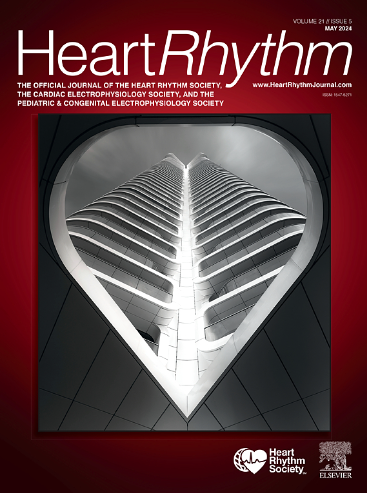Determinants and impact of postoperative atrial fibrillation burden during 2.5 years of continuous rhythm monitoring after cardiac surgery: Results from the RACE V prospective cohort study
IF 5.6
2区 医学
Q1 CARDIAC & CARDIOVASCULAR SYSTEMS
引用次数: 0
Abstract
Background
Early postoperative atrial fibrillation (POAF) is common after cardiac surgery and is associated with late-POAF recurrences. However, little is known about the burden of POAF and its potential impact on long-term outcomes after cardiac surgery, particularly on the risk for late-POAF recurrences.
Objective
The purpose of this study was to establish the distribution of POAF burden and to determine the association between early-POAF burden and late-POAF recurrences during 2.5 years of continuous rhythm monitoring after cardiac surgery in patients with and without preoperative history of atrial fibrillation (AF).
Methods
Patients undergoing cardiac surgery were prospectively enrolled and postoperatively continuously monitored with an implantable loop recorder for 2.5 years. All patients underwent extensive clinical assessment at baseline. During follow-up, all AF episodes were registered, and AF associated metrics, such as burden, were calculated for different time intervals. Early-POAF was defined as AF within first 90 postoperative days and late-POAF as AF after this interval.
Results
A total of 98 consecutive patients were included. POAF burden during the early postoperative phase was significantly higher compared to the late postoperative phase (P <.001). The longest individual POAF episode was strongly associated with increased POAF burden after adjusting for age, sex, and AF history (standardized Beta: 0.91, P <.001). Also, early-POAF burden was associated with late-POAF (re)occurrence after adjusting for age, sex, AF history (adjusted hazard ratio 1.93, 95% confidence interval 1.42–2.62, P <.001).
Conclusion
POAF burden was significantly associated with the longest individual POAF episode duration. Additionally, greater early-POAF burden was associated with increased late-POAF incidence, highlighting its potential in estimating the risk for long-term POAF recurrences.
心脏手术后 2.5 年连续心律监测期间术后心房颤动负担的决定因素和影响。
背景:术后早期房颤(POAF)在心脏手术后很常见,并且与晚期房颤复发有关。然而,人们对 POAF 的负担及其对心脏手术后长期预后的潜在影响知之甚少,尤其是对晚期 POAF 复发风险的影响:目的:确定 POAF 负荷的分布情况,并确定在心脏手术后 2.5 年的连续心律监测期间,有无术前房颤病史的患者早期 POAF 负荷与晚期 POAF 复发之间的关系:对接受心脏手术的患者进行了前瞻性登记,并在术后使用植入式环路记录器(ILR)进行了为期 2.5 年的连续监测。所有患者在基线时都接受了广泛的临床评估。随访期间登记了所有房颤发作,并计算了不同时间间隔的房颤相关指标(如负荷)。早期房颤定义为术后 90 天内的房颤,晚期房颤定义为术后 90 天后的房颤:结果:共纳入了 98 名连续患者。术后早期阶段的 POAF 负荷明显高于术后晚期阶段(pConclusion):POAF负荷与最长的单个POAF发作持续时间明显相关。此外,早期POAF负担越重,晚期POAF发生率越高,这突显了POAF负担在估计长期POAF复发风险方面的潜力。
本文章由计算机程序翻译,如有差异,请以英文原文为准。
求助全文
约1分钟内获得全文
求助全文
来源期刊

Heart rhythm
医学-心血管系统
CiteScore
10.50
自引率
5.50%
发文量
1465
审稿时长
24 days
期刊介绍:
HeartRhythm, the official Journal of the Heart Rhythm Society and the Cardiac Electrophysiology Society, is a unique journal for fundamental discovery and clinical applicability.
HeartRhythm integrates the entire cardiac electrophysiology (EP) community from basic and clinical academic researchers, private practitioners, engineers, allied professionals, industry, and trainees, all of whom are vital and interdependent members of our EP community.
The Heart Rhythm Society is the international leader in science, education, and advocacy for cardiac arrhythmia professionals and patients, and the primary information resource on heart rhythm disorders. Its mission is to improve the care of patients by promoting research, education, and optimal health care policies and standards.
 求助内容:
求助内容: 应助结果提醒方式:
应助结果提醒方式:


